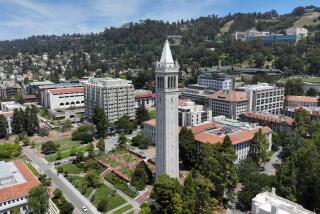1 in 4 female undergrads said they were sexually assaulted on campus. At USC, it’s nearly 1 in 3
- Share via
One in four female undergraduates at leading campuses across the country say they have been sexually assaulted by force or because they were passed out, asleep or incapacitated by alcohol or drugs and unable to consent, according to a national survey released Tuesday.
Three California universities participated in the survey of 181,752 students conducted for the Assn. of American Universities, an organization of the nation’s 62 leading public and private research universities. USC reported higher numbers than the national average, with 31% of female undergraduates saying they were sexually assaulted sometime during their college years. The rate was 23.8% at Stanford and 14.3% at Caltech.
The University of California conducts its own sexual misconduct survey and did not join the AAU effort.
The survey by AAU and Westat, a leading social science research firm, represents the nation’s largest-ever effort to examine college sexual assault and expands on its initial groundbreaking study in 2015. The survey, which received a 21.9% response rate, was conducted in the spring at 33 public and private campuses, including Yale, Harvard, Rice, Northwestern and the University of Oregon.
Among other things, it examined the prevalence of nonconsensual sexual contact — penetration and touching — along with sexual harassment, stalking and other misconduct.
Since the Obama administration began cracking down on college sexual misconduct in 2011, universities across the country have scrambled to improve education, training and support for victims. Despite the attention, the survey found that reports of sexual assault had increased slightly — 3% among undergraduate women. The vast majority of cases involved alcohol.
In addition, nearly two-thirds of students lacked basic knowledge about sexual assault, including how to define it and where to get help.
“The results provide cause for both hope and continued concern,” AAU President Mary Sue Coleman said in a statement. But she said the large-scale effort was “a testament to the commitment that America’s leading research universities have to fighting these problems and improving the campus climate around these issues.”
The AAU survey found that student experiences with sexual misconduct varied widely by college, program and gender. Overall, 13% of students surveyed said they had been victims of nonconsensual sexual contact.
Undergraduate women reported the highest prevalence of sexual assault — 25.9% compared with 9.7% of female graduate or professional students, and 6.8% for undergraduate men.
Among undergraduate students who identified as TGQN — transgender, nonbinary/genderqueer, gender questioning, or who did not list a gender — 22.8% said they had been victims of sexual assault.
In addition, undergraduate TGQN students reported the highest rate of sexual harassment — behavior defined as acts with sexual connotations that interfered with academic or professional performance, limited participation in an academic program or created an intimidating or hostile environment. The rate of students who experienced both harassing behavior and said it created a hostile environment was 46.3% for TGQN students, 31.3% for undergraduate women and 18.9% for all students.
On the upside, the survey found that student knowledge about sexual assault, although still low, had risen significantly in the last four years. But most still do not report incidents or use university resources for support. Victims of sexual assault told researchers they did not report their experiences to campus authorities because they thought they could handle it themselves, did not consider it serious or were embarrassed or ashamed.
At USC, Sarah Van Orman, associate vice provost for student health, said she could not say whether her school’s higher numbers were tied to mass allegations of sexual assault by a former campus gynecologist, George Tyndall.
She said she was concerned that knowledge about sexual assault decreased since 2015, in contrast to national trends. In addition, USC undergraduate women reported far less confidence that the university would take their reports seriously than did their peers at other campuses surveyed, 38.6% compared with 53%.
“What this tells us is that we have more work to do on this campus,” said Van Orman, who is a physician. “We haven’t shown the kind of movement over the last four years that I would have wanted to see.”
But she said she was heartened that the percentage of undergraduate women who sought campus help had more than doubled, from 14.5% in 2015 to 32.8% in 2019. In addition, far more USC students were reporting sexual assault, more than doubling from 13.9% to 31.5% during that same time period.
Van Orman said the university had recently launched several new efforts to guard against sexual misconduct. In the last six months, USC has hired four full-time staff members and four students, working part time, to focus exclusively on prevention education and training. The university is also in the process of hiring four people as confidential advocates, available 24/7 to give emotional and logistical support to victims.
USC is also rolling out its first-ever mandatory, in-person training to all incoming first-time undergraduates on affirmative consent, which is now required by law for every sexual act. Although the university already requires online training about sexual misconduct for all students during the registration process, Van Orman said the in-person program would help build on that knowledge.
In addition, USC is expanding a voluntary training program for student leaders on bystander intervention, which encourages those who witness situations that could lead to sexual assault to step in. The survey found that three-fourths of USC students who witnessed such situations intervened, a far higher percentage than the national average of 45.1%.
“We know prevention is most effective with multiple doses,” Van Orman said.
In a letter to the campus community Tuesday, Stanford Provost Persis S. Drell said she was “deeply troubled” by the survey results. After undergraduate women, TGQN students reported the second-highest rate of sexual assault, 21.7%. Those students also reported the highest rate of sexual harassment at 55%.
The lack of confidence among Stanford students that university officials would properly handle sexual misconduct complaints is “distressing,” Drell said. While nearly half of undergraduate women surveyed said they believed officials would treat those reports seriously, only 29% were confident Stanford would conduct a fair investigation. TGQN students were even more skeptical, with 19% believing in a fair investigation.
Drell said Stanford would launch a new support website for TGQN students to provide resources for them and education for faculty and staff about their needs. She also announced that the YWCA of Silicon Valley would provide an on-site community coordinator at Stanford to give campus members an alternative avenue for help outside the university.
“The prevalence of sexual violence on our campus is a problem that cannot be solved by one person, one group or one office,” Drell said, adding that the commitment of the entire Stanford community is needed to change the culture.
Caltech students reported sexual misconduct problems at lower rates than the national average. Overall, 5.7% of students said they were sexually assaulted by force or because they were unable to consent, including 14.3% of undergraduate women, 3.1% of undergraduate men, 7.8% of graduate or professional women, 2.2% of graduate men and 11.5% of TGQN students.
Sexual harassment was experienced by 46.4% of TGQN students, 29.5% of graduate or professional women, 26.6% of undergraduate women, 11.3% of undergraduate men and 8.4% of graduate men.
More to Read
Sign up for Essential California
The most important California stories and recommendations in your inbox every morning.
You may occasionally receive promotional content from the Los Angeles Times.











